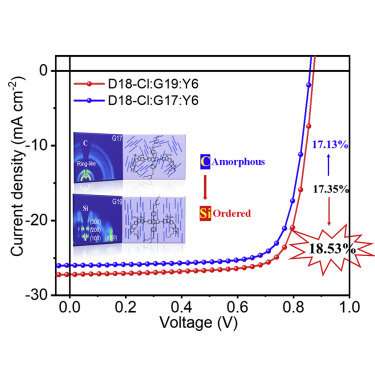Microstructure morphology fine-tuning of active layer film boosts organic solar cell efficiency

The power conversion efficiency (PCE) of organic solar cells (OSCs) are demonstrated to be improved via the microstructure morphology fine-tuning of active layer films. Thanks to the appealing advantages like light weight, mechanical flexibility and roll-to-roll processability, OSCs have drawn increasing attention. As a promising power source for flexible electronic systems, they feature relatively high PCE, which still needs to be improved.
Small molecular donor guests play an active role in developing OSCs based on the ternary strategy, which is an effective approach to optimize photovoltaic performance.
In a study published in Joule, a group led by Prof. Ge Ziyi at the Ningbo Institute of Materials Technology and Engineering of the Chinese Academy of Sciences designed and synthesized two small molecular donors with similar chemical structures, G17 and G19, which differ in molecular stacking order. G17 exhibits an amorphous orientation, while the G19 features an extremely ordered edge-on orientation.
The researchers employed the ternary strategy by introducing the third component G17 and G19 into the D18-Cl:Y6 binary systems respectively to fine-tune the microstructure morphology and light absorption of the films.
The non-fullerene rigid organic solar cells (OSCs) developed based on G19, the relatively ordered small molecular donor G19, achieved a superior power conversion efficiency (PCE) of 18.5%, which are even among the best performance for rigid OSCs reported to date. Correspondingly, the G17-based rigid OSCs only showed a relatively low PCE of 17.13%.
The excellent photovoltaic performances of D18-Cl:G19:Y6 based rigid OSCs can be attributed to the highly ordered molecular stacking of the donor guest, which enhance phase separation and carrier transport.
In addition, the researchers obtained a stabilized PCE of 15.9% for flexible OSCs, which was the highest PCE reported for flexible state-of-the-art OSCs. Most importantly, the ternary flexible OSCs exhibited excellent mechanical stability as they could retain about 93% of the original PCE after 1000 bending cycles.
This study made breakthroughs in both rigid and flexible OSCs, and shed light on the construction of efficient ternary systems with incorporating highly ordered molecular donors.
More information: Zhenyu Chen et al, Small-molecular donor guest achieves rigid 18.5% and flexible 15.9% efficiency organic photovoltaic via fine-tuning microstructure morphology, Joule (2021). DOI: 10.1016/j.joule.2021.06.017


















